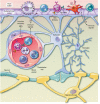The immune system and psychiatric disease: a basic science perspective
- PMID: 31125426
- PMCID: PMC6693968
- DOI: 10.1111/cei.13334
The immune system and psychiatric disease: a basic science perspective
Abstract
Mental illness exerts a major burden on human health, yet evidence-based treatments are rudimentary due to a limited understanding of the underlying pathologies. Clinical studies point to roles for the immune system in psychiatric diseases, while basic science has revealed that the brain has an active and multi-cellular resident immune system that interacts with peripheral immunity and impacts behavior. In this perspective, we highlight evidence of immune involvement in human psychiatric disease and review data from animal models that link immune signaling to neuronal function and behavior. We propose a conceptual framework for linking advances in basic neuroimmunology to their potential relevance for psychiatric diseases, based on the subtypes of immune responses defined in peripheral tissues. Our goal is to identify novel areas of focus for future basic and translational studies that may reveal the potential of the immune system for diagnosing and treating mental illnesses.
Keywords: brain; human; neuroimmunology; psychiatry.
© 2019 British Society for Immunology.
Figures


References
-
- Organisation Mondiale de la Santé (OMS). The global burden of disease 2004, update . World Health Organ 2004; 146 10.1038/npp.2011.85. - DOI
Publication types
MeSH terms
Grants and funding
LinkOut - more resources
Full Text Sources
Other Literature Sources
Medical

